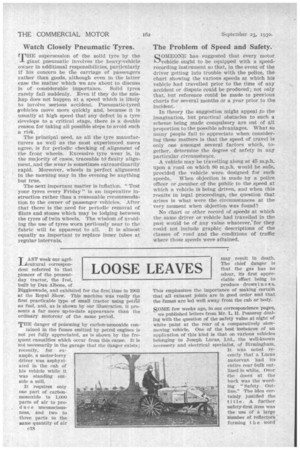LOOSE LEAVES
Page 40

Page 41

If you've noticed an error in this article please click here to report it so we can fix it.
T AST week our agri lcultural correspondent referred to that pioneer of the presentday tractor, the Ivel, built by Dan Albone, of Eiggleswade, and exhibited for the first time in 1903 at the Royal Show. This machine was really the first practicable type of small tractor using petibl as fuel, and, as is shown by our illustration, it presents a far more up-to-date appearance than the ordinary motorcar of the same period.
THE danger of poisoning by carbon-monoxide contained in the fumes emitted by petrol engines is not yet fully appreciated, as is shown by the fre quent casualties which occur from this cause. It is not necessarily in the garage that the danger exists; recently, for example, a motor-lorry driver was asphyxiated in the ca h of his vehicle while it was standing outside a mill.
It requires only one part of carbonmonoxide to 1,000 parts of air to produce unconsciousness, and two to three parts to the same quantity of air c18 may result in death. The chief danger is that the gas has no odour, its first appreciable effect being to produce drowsi n e s s. This emphasizes the importance of making certain that all exhaust joints are in good order and that the fumes are led well away from the cab or body.
SOME few weeks ago, in our correspondence pages, we published letters from Mr. L. H. Pomeroy dealing with the question of the safety value at night of white paint at the rear of a comparatively slowmoving vehicle. One of the best instances of an application of this kind is that on various vehicles belonging to Joseph Lucas, Ltd., the well-known accessory and electrical specialist, of Birmingham. It was noted re.cently that a Lucas motorvan had its entire rear bulk outlined in white. Over the doors at the back was the wording "Safety Outline." The idea certainly justified the ti tle. A further safety-first item was the use of a large . number of reflector's forming t h e word' " tueas " on a board below the doers. Obviously, this had another purpose. in life, but the driver who could run any risk of collision with the rear of this vehicle, would not be safe upon the road.
TO obtain a true impression of the value of rural bus services in this country one must penetrate to the remote farmlands, away from big towns, away from railways. A tour of the by-ways of western Cornwall, beyond the industry of Redruth and the tourist centres of Truro, Newquay and Penzance, soon shows in their true light the regular. motorbus services upon which the inhabitants rely so implicitly. The name Western National is a byword down there. The familiar dark-brown bus is met in the most deserted lanes wending its way, strictly to time-table, past this farm and that village, through the tiny "church towns" to the fishing villages, and linking them up with thet more important centres and the railway stations. Almost all the local inhabitants depend upon the Western National for many of their daily needs and it is quite an accepted adjunct to the local life.
WE have had various classes of tout, and the latest is the one who endeavours to induce passers-by to take aerial flights at 5s. upwards. The procedure is to bring an aeroplane right up to the side of the road where the interest of motorists tempts them to slow down while passing.












































































































